

What is Connected Learning. Ninth-grader Charles Raben has seen first-hand that by connecting the many spheres of his life -- peers, interests and academic pursuits -- new learning experiences can and will present themselves in both organized and unstructured ways.
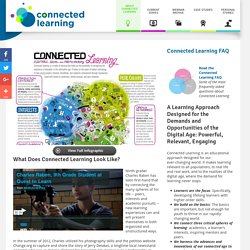
In the summer of 2012, Charles utilized his photography skills and the petition website Change.org to capture and share the story of Jerry Delakas, a longtime local newsstand operator who was in danger of losing his New York City license over a technicality. "I wanted to have that experience of creating change myself. " The petition-making process proved to be a life-changing learning experience for the teen. Connected Learning. Connected Learning Explained for Teachers. What Is Connected Learning? There are a ton of resources floating around out there about connected learning.
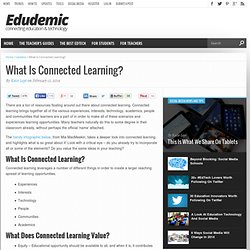
Connected learning brings together all of the various experiences, interests, technology, academics, people and communities that learners are a part of in order to make all of these scenarios and experiences learning opportunities. Many teachers naturally do this to some degree in their classroom already, without perhaps the official ‘name’ attached. The handy infographic below, from Mia MacMeekin, takes a deeper look into connected learning, and highlights what is so great about it! Look with a critical eye – do you already try to incorporate all or some of the elements? Do you value the same ideas in your teaching? iTunes U – Lär dig vad som helst, var som helst, när som helst. 6 Ways To Use Google Hangouts In The Classroom.
Google's suite of technology products has far-reaching followings in the social and business sector, but did you know nearly all of their products are easily integrated into the classroom?
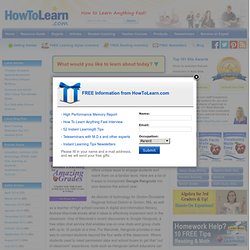
For instance, Google's "Hangouts" feature is a dynamic function of the Google platform that offers unique ways to engage students and reach them on a familiar level. Here are a list of 6 ways to incorporate Google Hangouts into your lessons this school year. As director of technology for Groton-Dunstable Regional School District in Groton, MA, as well as a teacher of high school courses in digital and information literacy, Andrew Marcinek knows what it takes to effectively implement tech in the classroom. One of Marcinek’s recent discoveries is Google Hangouts, a free video chat service that enables one-on-one chats and group chats with up to 10 people at a time.
For Marcinek, Hangouts provides a new way to connect students beyond the four walls of the classroom. 1. 2. 3. 4. 5. 6. CONNECTED. Connected Learning, Project-Based Learning, and Learners as Authors. High-school projects generally aren’t available as ebooks on Amazon.com.

Then again, most high-school projects don’t effectively and engagingly lead us into an exploration of contemporary “webucation” while providing a first-rate example of what project-based learning can produce among students of any age. Michaelsen herself describes the book as a “compendium of articles, advice and how-to instructions, designed to help high school teachers and their students around the globe shift from classrooms that are isolated and teacher-centered to digitally rich environments where learning is student-driven and constantly connected to the global internet.” But there’s no need to believe that the publication doesn’t apply to a far wider audience of trainer-teacher-learners. The writers’ goal is explicitly stated up front: “…we want to teach YOU how to master the skills of webucation. Whitney Burke: Connected Learning: A Learning Approach Designed for Our Times. Between the years of 1992 and 2005, I spent a great deal of time confined to a desk learning the three Rs: reading, writing and arithmetic.
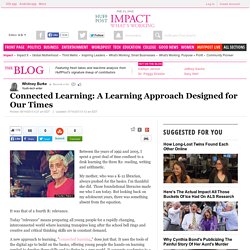
My mother, who was a K-12 librarian, always pushed for the basics. I'm thankful she did. Those foundational literacies made me who I am today. But looking back on my adolescent years, there was something absent from the equation. It was that of a fourth R: relevance. Today "relevance" means preparing all young people for a rapidly changing, interconnected world where learning transpires long after the school bell rings and creative and critical thinking skills are in constant demand. ‘Connected’ learning. Canadian principal George Couros spent last week sharing his ‘connected’ learning with our teachers and leaders.
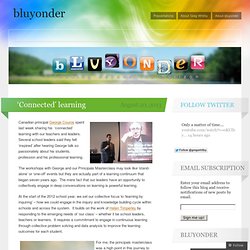
Several school leaders said they felt ‘inspired’ after hearing George talk so passionately about his students, profession and his professional learning. Connected Learning Principles. We are living in a historical moment of transformation and realignment in the creation and sharing of knowledge, in social, political and economic life, and in global connectedness.

There is wide agreement that we need new models of education suited to this historic moment, and not simply new models of schooling, but entirely new visions of learning better suited to the increasing complexity, connectivity, and velocity of our new knowledge society. Fortunately, we are also able to harness the same technologies and social processes that have powered these transformations in order to provide the next generation with learning experiences that open doors to academic achievement, economic opportunity, and civic engagement.
A Day in the Life of a Connected Educator – Using social media in 21st century classrooms. One of our main goals at Powerful Learning Practice is to turn educators into 21st Century educators.
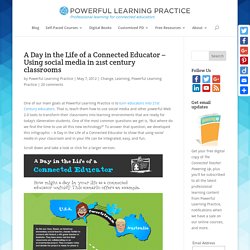
That is, teach them how to use social media and other powerful Web 2.0 tools to transform their classrooms into learning environments that are ready for today’s iGeneration students. One of the most common questions we get is, “But where do we find the time to use all this new technology?” 17 Tech Terms Connected Educators Must Know. From time to time, I find myself saying ridiculous things.

Ridiculous in the ‘I grew up in the ’80′s’ sort of sense. Specifically, I have a hard time saying ‘record’ in reference to a TV show or movie, and instead I am inadvertently old-school and often refer to it as ‘videotaping’. I know, I know. No one has owned a VCR in years except for my grandma. But when I came across this handy visual it brought to mind things that truly connected educators should probably know before the upcoming school year, I was happy to see that I’m not the only one that needs to update my colloquial vocabulary. Tech Terms That Are Changing (or going away!) .com surf (as in, the web) click dial www. stream piracy thread wireless tablet torrent Tech Terms Of The Future glassed up anti-social print. Ten Tips for Becoming a Connected Educator. We all know that education budgets are getting cut more and more, and that meaningful professional-development opportunities have unfortunately become a bit of an oxymoron in education.
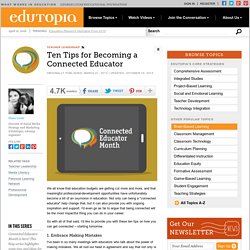
Not only can being a "connected educator" help change that, but it can also provide you with ongoing inspiration and support. I'd even go as far to argue that being connected will be the most impactful thing you can do in your career. So with all of that said, I'd like to provide you with these ten tips on how you can get connected -- starting tomorrow. 1. Embrace Making Mistakes I've been in so many meetings with educators who talk about the power of making mistakes. 2. 5 Powerful Common Core Tools For The Connected Educator. With forty-five states plus Washington DC and four territories adopting the Common Core State Standards (CCSS), I’m a little surprised educators are still questioning the benefits of becoming a connected educator. I’ve enjoyed the privilege of serving as the Elementary School Principal in Boyne City, Michigan for 13 years.
I became a principal because I believe in the power of visionary leadership. I love what happens when you get a group of individuals behind an idea and working towards a common set of goals. If implemented correctly, the Common Core presents the opportunity for the greater educational community to work together towards the ultimate goal of educating our youth. I’ve enjoyed a relatively seamless transition to the CCSS thanks to a hard-working and dedicated teaching staff. Some of the tools we’ve found to be most effective for fostering these connections include the use of Twitter , Edmodo , iTunes U , YouTube , and Google Hangouts . Twitter Edmodo iTunes U. What is Connected Learning. Learning 2.0 is Dumb: Use ‘Connected Learning’ Instead. Going forward, and as best I can, I’ll use the term ‘Connected Learning’ to describe a knowledge ecosystem made up of formal, informal and social learning behaviours and modalities.
It’s about time I (and perhaps you as well) retire the term Learning 2.0. There are a few reasons for this: Therefore, I present to you ‘Connected Learning’ … at least from a modality perspective: If ‘Connected Learning’ is part formal, part informal and part social, there will always be the act of ‘connecting’ one’s self to people, content, systems, networks, etc. during the learning process itself … and it may occur through several mediums.
Formal: a self-contained & scheduled learning event, typically but not always tracked, providing a comprehensive and at times logical or sequential approach to a topic. Informal: an opportunity without conventionalism, atypical to formal learning, providing guidance, expertise or acumen on the go. The Connected Learning Environment.